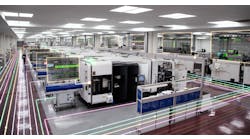In this issue, American Machinist begins a series of in-depth looks at the Computer Aided Machining (CAM) software packages available on the market to provide unbiased, detailed information that shop owners and managers can use to identify the CAM packages that offer the potential for the most improvements in their operations.
In the April issue of American Machinist, we identified the major developers of Computer Aided Machining (CAM) software. That article, “The Players in CAM Software Development” is available at www.americanmachinist.com/304/Issue/Article/False/79816/Issue.
In this and coming issues, we will take a close look at the software packages listed on the table that accompanied that article, and talk about the uses that the software developers intended for their products.
While we intend this to be a comprehensive review of CAM software, we cannot claim that it is as exhaustive a review that we hope shop owners and managers conduct before they make a final decision on a product. <<
There are more than 20 developers of CAM packages, and each offers software designed, essentially, to do the same thing – turn a part design into toolpaths and G-code that can be used to machine that part.
Most of the software products offered are sophisticated, mature products that are used by thousands. Even though all of the software is designed to do the same thing, the approaches that the packages take are unique.
This series of articles will look at these CAM packages, and will talk about the differences between the packages with the aim of helping shop owners and managers to work through the array of choices they have, and the ways that a specific package can be “the best” for an individual shop and what that means for their shops’ productivity and competitiveness. The process of CNC programming is idiosyncratic. That means that each programmer has his own unique style and approach to it. In fact, there is a joke that says if you ask five CNC programmers to write a program to machine the same part with the same software to run on the same machine you will probably get six different programs.
That’s not really a joke. It’s the way CNC programming is done. So, with so many variables involved, and the variables that go along with each person in a shop and each programmer, what’s a shop to look for when it shops for a CAM program?
Usually, a shop will start by going through the prism of its CNC programmers and their biases when it starts to look at CAM packages. Consequently, a package that looks “easy to use” for one shop might look like a programming nightmare to another because of how familiar the package is to its programmers. More often than not, the result is that a shop will purchase a CAM software package primarily because the shop’s CNC programmers are more comfortable or familiar with it than other, perhaps better, packages.
In addition to relying heavily on their programmers, shop owners and managers can get information and suggestions about evaluating and buying CAM packages from only two sources: Machine tool distributors and other shop managers.
Chances are that neither of those sources were likely to have evaluated the CAM packages available, and those sources have their own biases and experiences that influence their recommendations.
An informal survey conducted by American Machinist of what CNC programmers and shop owners look at when they evaluate CAM packages revealed that most of the standard performance benchmarks do not influence the final decision to buy.
What is important are the answers to several consistent questions:
- Will the software easily do what I need it to do?
- Can the software meet possible future needs as well as current needs?
- How quick and easy is it to learn to use the software efficiently?
- What kind of training and support is available and how much will it cost?
- Is the software developer and distributor going to be around five years from now?
American Machinist’s indepth look at the CAM packages will focus on answering those questions and giving shop owners and managers a clear picture of each package’s suitability for use in their shops. Then, it is up to the shop to take a detailed look at promising packages to determine just how “easy” those packages are to use in that shop.
The first CAM software package analyzed is a suite of packages provided by one software developer, Delcam Plc. (www.delcam.com).






